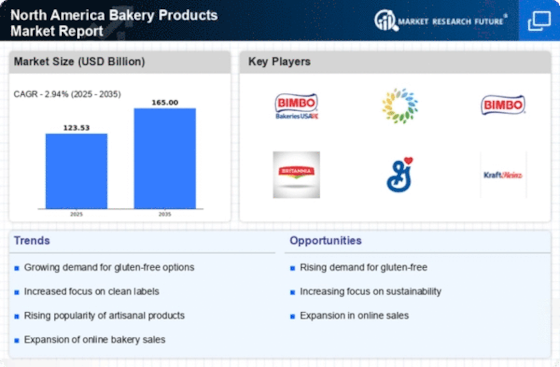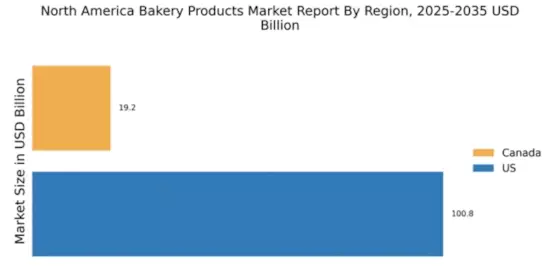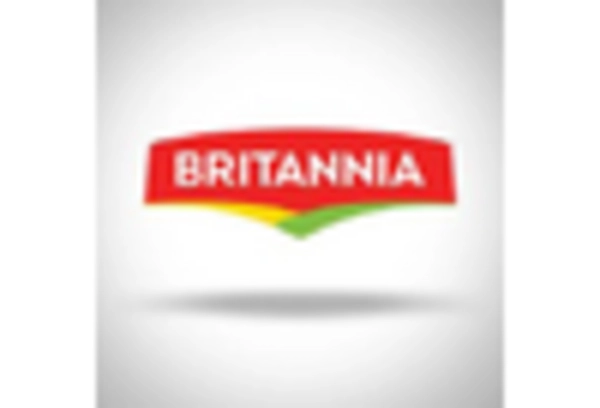Adoption of Clean Label Products
The clean label movement is gaining traction within the bakery products market in North America, as consumers become increasingly aware of the ingredients in their food. There is a growing preference for products that are free from artificial additives, preservatives, and genetically modified organisms (GMOs). This trend is reflected in the market, where clean label products have seen a growth rate of approximately 15% annually. As a result, many bakeries are reformulating their recipes to meet these consumer demands, emphasizing transparency and simplicity in their ingredient lists. The bakery products market is thus evolving to prioritize health-conscious choices, aligning with the values of modern consumers who seek authenticity and integrity in their food.
Convenience and On-the-Go Options
In the fast-paced lifestyle of North America, the bakery products market is adapting to the increasing demand for convenience. Consumers are gravitating towards ready-to-eat and on-the-go options, such as pre-packaged pastries, muffins, and snack bars. This shift is particularly evident among busy professionals and families seeking quick meal solutions without compromising on quality. Data indicates that the convenience segment of the bakery products market has expanded by approximately 12% over the past year. Retailers are responding by enhancing their product lines to include portable and easy-to-consume items, thereby capturing a larger share of the market. This trend highlights the importance of convenience in the bakery products market, as it aligns with the evolving consumer lifestyle.
Rising Demand for Artisan Products
The bakery products market in North America is experiencing a notable shift towards artisan and specialty baked goods. Consumers are increasingly seeking products that offer unique flavors, textures, and high-quality ingredients. This trend is driven by a growing appreciation for craftsmanship and authenticity in food. According to recent data, the artisan bread segment alone has seen a growth rate of approximately 8% annually. This demand for artisanal products is reshaping the competitive landscape, prompting traditional bakeries to innovate and diversify their offerings. As a result, the bakery products market is witnessing an influx of small-scale producers who emphasize local sourcing and traditional baking methods, catering to the evolving preferences of discerning consumers.
Innovations in Gluten-Free Offerings
The bakery products market in North America is witnessing a significant rise in gluten-free offerings, driven by the increasing prevalence of gluten sensitivities and celiac disease among consumers. This trend is not merely a fad; it reflects a broader shift towards dietary inclusivity. Recent statistics suggest that the gluten-free segment has grown by over 30% in the last five years, indicating a robust demand for alternative grain products. Bakeries are innovating to create gluten-free bread, pastries, and snacks that do not compromise on taste or texture. This expansion of gluten-free options is reshaping the bakery products market, as it caters to a diverse consumer base seeking healthier and more inclusive dietary choices.
Expansion of Plant-Based Alternatives
The bakery products market in North America is increasingly embracing plant-based alternatives, reflecting a broader trend towards vegetarian and vegan diets. This shift is driven by health considerations, environmental concerns, and ethical choices. Recent market analysis indicates that the plant-based segment within the bakery products market has expanded by approximately 20% over the past two years. Bakeries are innovating to create plant-based breads, pastries, and desserts that appeal to a wide audience, including those who may not strictly adhere to a vegan diet. This expansion of plant-based options is reshaping the bakery products market, as it caters to a growing demographic that values sustainability and health.


















Leave a Comment